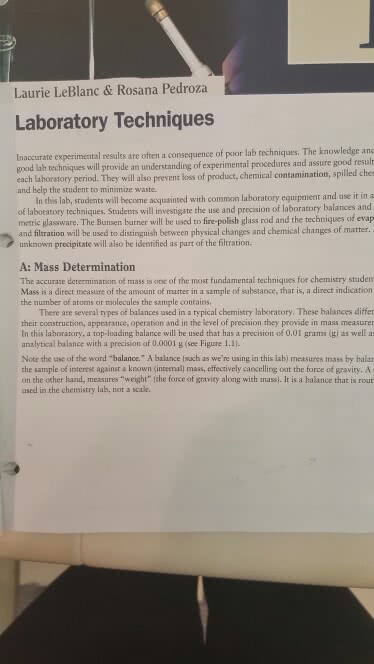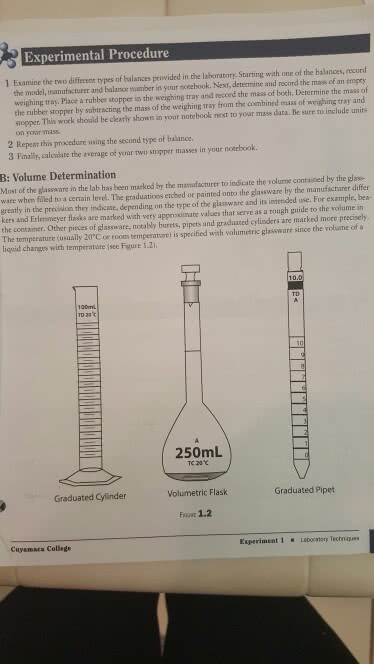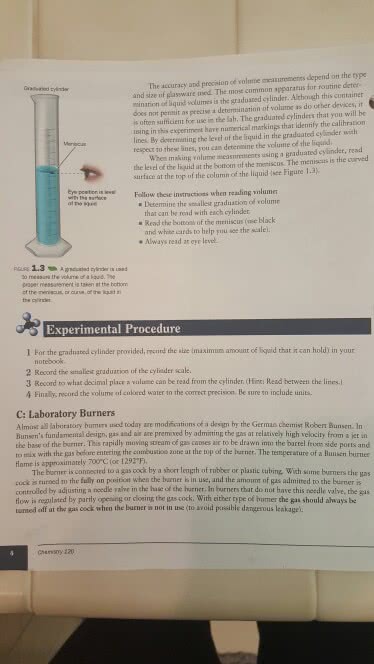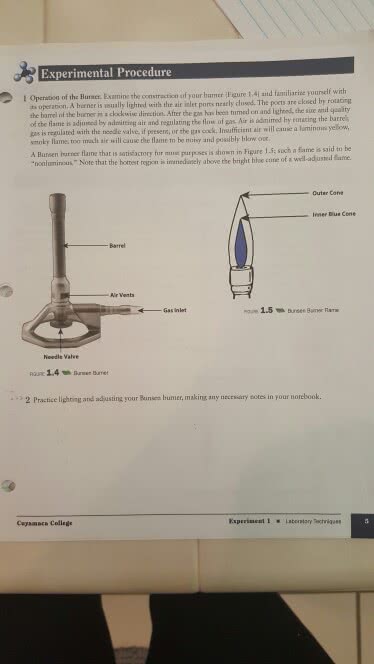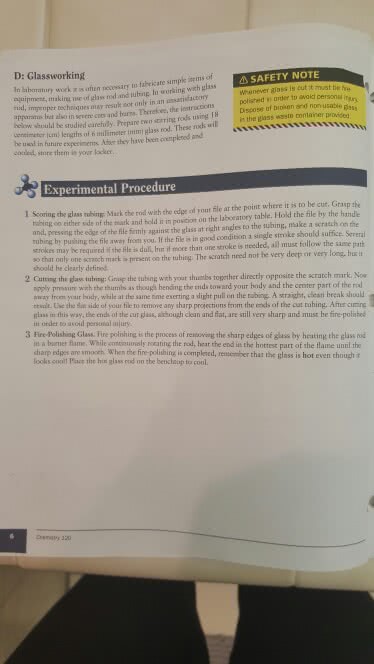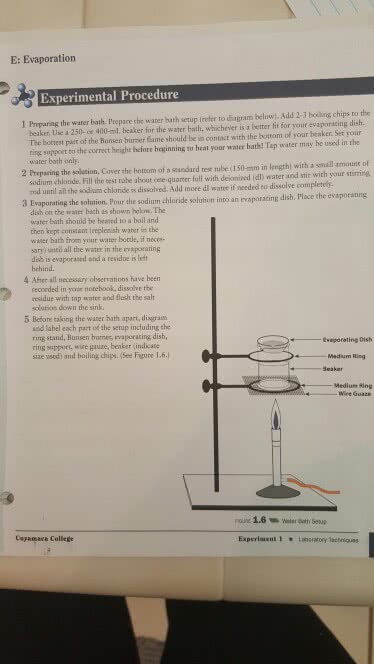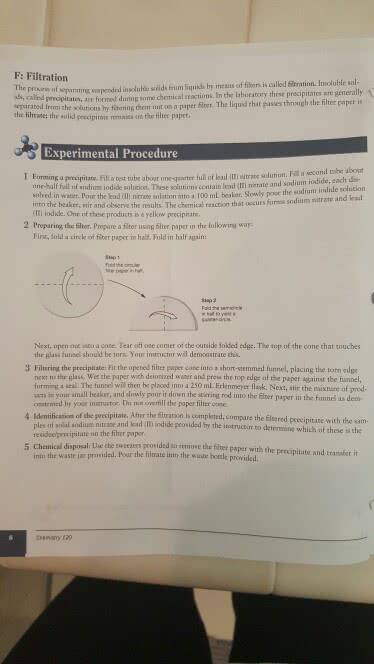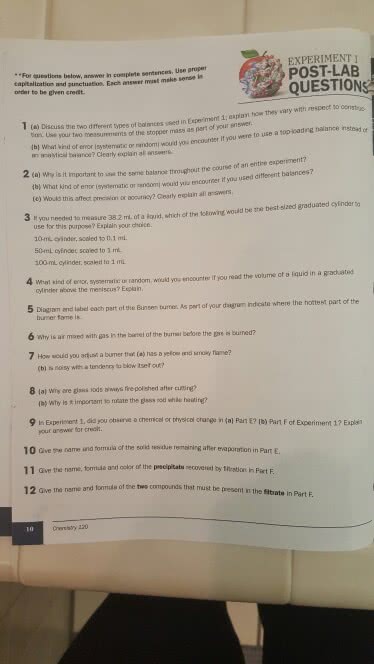CHEM 1005 Lecture Notes - Lecture 1: Gravimetric Analysis, Reagent, Colloid
Document Summary
Get access


Related textbook solutions
Chemistry: Structure and Properties
Basic Chemistry
Principles of Chemistry Molecular Approach
Principles of Chemistry Molecular Approach
Chemistry: Structure and Properties
Chemistry: A Molecular Approach
Chemistry: A Molecular Approach
Principles of Chemistry: A Molecular Approach
Chemistry: The Central Science
Related Documents
Related Questions
2.) Bart was a truly superb organic laboratory student. Unfortunately, his partner Homer was a bit careless. Bart was carefully saving solid samples of benzoic acid and ethyl-4-aminobenzoate in his lab locker; he needed to run melting point determinations on these samples after they had dried for a week. Before he got a chance, Homer picked up both samples, dumped them together in a beaker, and was about to carry them to a waste jar. Bart recovered the beaker, and decided he could easily separate the two components. How would Bart best recover the ethyl-4-aminobenzoate from the solid mixture ?
a. Dissolve the solid mixture in ether, extract the ether solution with 10% aqueous sodium hydroxide, collect the aqueous layer and add an acid.
b. Dissolve the solid mixture in ether, extract the ether solution with 10% aqueous hydrochloric acid, collect the aqueous layer and add a base.
c. Dissolve the solid mixture in ether, extract the ether solution with 10% aqueous sodium hydroxide, collect the ether layer and let the ether evaporate.
d. Dissolve the solid mixture in ether, add about the same volume of water, shake, separate and discard the aqueous layer, let the ether layer evaporate and collect the product.
3.) After Bart separated the benzoic acid + ethyl-4-aminobenzoate mixture, he recorded nujol mull IR spectra for the separated materials, as well as for some naphthalene he had in his locker. The resulting spectra are in Figure 1. Which spectrum is most likely the spectrum of benzoic acid ?
A) Fig 1-A B) Fig 1-B C) Fig 1-C D) Fig 1-D
E) None of the spectra are a good match
4. ) Bart also had vials of acetone, chloroform, and toluene which Homer dumped into another waste beaker. Bart sees no problem, he thinks he can separate this mixture also. What technique would be his best choice ?
A.) recrystallization
B.) simple distillation C
.) fractional distillation
D.) column chromatography with an alumina stationary phase
5.) If the 3-component mixture of problem 4 were injected into a gas chromatograph, which component would have the shortest retention time ? ( assume a helium carrier gas, a non-polar stationary phase, injector and t.c. detector at 150 C, column at 75 C )
A) Acetone
B) Chloroform
C) Toluene
D) There is not enough information provided.
E) The components are not likely to separate under the conditions described.
6.) Which of the following statements about the Diels-Alder reaction is FALSE ?
A) It is a [2+4] cycloaddition.
B) It is a reaction involving pi-electrons.
C) It is a concerted reaction.
D) It is a reaction favored by entropy considerations.
E) It is a thermal reaction.
7.) When the following two molecules combine by a Diels-Alder reaction, the product will contain two new sigma bonds between atoms which were not previously bonded. Between which pairs of atoms will these bond be formed ?
A) b-d and f-g
B) j-k and o-m
C) b-k and g-m
D) d-k and f-m
E) b-j and g-o
8.) Bart and Homer have returned to the lab. They are trying to run a Diels-Alder reaction, starting with 4.80 grams of cyclohexadiene (MW 80.13) and 5.88 (MW 98.06) grams of maleic anhydride. At the end of the reaction, Homer recovered 7.38 grams of the adduct, but has no idea what to report as a percent yield. Bart pulls out a calculator and quickly comes up with a number. What was the percent yield he calculated ? (Choose the closest answer, within 1 % )
A) 79.7 % B) 69.2 % C) 65.0 % D) 45.5 %
E) None of the above choices are close ( i.e. within 1% )
9.)Which of the following statements is FALSE about the experimental process used in the Diels-Alder reaction?
A) Glassware should be washed and rinsed with hot tap water immediately before adding reagents.
B) Maleic Anhydride is toxic.
C) The product may be recrystallized from the methanol solvent.
D) The I.R.'s of the product is different from maleic anhydride
E) No flames are used during this reaction.
10.) Suppose you have determined a GC spectrum for a sample oil containing an unknown diene. You are preparing to run a Diels-Alder reaction using this oil. You find 3 peaks. From determination of peak area, you find that the percent compositions represented by the peaks are: peak A is 55 percent , peak B is 30 percent, and peak C is 15 percent. The M.W. of your diene is 136 g/m. How many grams of Maleic Anhydride (M.W. 98 g/m) will you use to react with your 2.5g sample of crude diene? (The largest GC peak is the diene)
A) 0.99 B) 1.25 C)1.375 D)1.91 E)2.5
11.) In the proton NMR of ethyl acetate, which group of hydrogens would appear the most upfield ?
A. A
B. B
C. C
12.) In the proton NMR of ethyl acetate, which group of hydrogens is the most magnetically shielded?
A.) A
B.) B
C.) C
13.) Rank the proton groups of the ethyl acetate molecule in order of increasing chemical shift.
A.) BAC B.) CAB C.) ACB D.) BCA
14.) Which of the following could happen when infrared radiation is absorbed by a molecule ?
Electrons are promoted from filled to empty molecular orbitals
The orientation of a nuclear spin state changes.
Intra-molecular bond angles change
molecule begins to rotate more rapidly
molecule may glow in the dark
15.) Infrared absorption spectra of organic molecules are often presented as a plot of transmittance versus wavenumber. What is the definition of a wavenumber ?
one wavenumber = one micron
one wavenumber = one centimeter
one wavenumber = one reciprocal micron
one wavenumber = one reciprocal centimeter
wavenumber is the same as wavelength, and can be expressed in any unit of length
16.) Which bond would you expect to have the highest vibrational frequency (stretching) ?
A) Urea
B) Sodium Carbonate
C) Potassium Iodide
D) Sulfuric Acid
E) Sodium Nitrite
Questions 17 through 20 are spectra identification problems. You must identify two unknowns, referred to as compound A and compound B. Table I, attached at the end of the exam, has a list of possible compounds. Each compound listed in table I has a two digit identification code. After you have identified compound A, you will enter the first digit of its identification code as the answer for question 18, and then enter the second digit of the code as the answer for question 19. You then repeat this process for compound B in questions 20 and 21.
17.) Compound A gives a positive acetyl chloride test, and the infrared and NMR spectra are given in figures 2A thru 2C. Consult table I and the spectra, identify compound A. The first digit of the code corresponding for compound A is
A) 1 B) 2 C) 3 D) 4 E) 5
18.) The second digit of the code for compound A is
A) 1 B) 2 C) 3 D) 4 E) 5
19.) You have run a series of qualitative chemical tests on compound B, all of which came out negative. The negative chemical tests included acetyl chloride, chromic acid, potassium permanganate, silver nitrate, and 2,4-dinitrophenylhydrazine. The infrared and NMR spectra of compound B are given in the attached figures 3A thru 3C. Identify compound B. The first digit of the code in table I corresponding to compound B is
A) 1 B) 2 C) 3 D) 4 E) 5
20.) The second digit of the code for compound B is
A) 1 B) 2 C) 3 D) 4 E) 5
21.) Which of the following statements regarding Grignard reagents is FALSE ?
A. The Grignard reagent is an example of an organometallic compound.
B. Grignard reagents are stable in anhydrous ether solutions.
C. A Grignard reagent contains electrophilic carbon.
D. Once prepared , a Grignard reagent should be used quickly.
E. Grignard reagents tend to act as Bronsted bases.
22.) Suppose that in the synthesis of benzoic acid , a student uses 1.215 grams of magnesium , 7.575 grams of bromobenzene , and 22.641 grams of dry ice. If the mass of benzoic acid obtained were 4.530, what was the percent yield?
A. 32.1
B. 66.5
C. 77.0
D. 88.6
E. None of the above are correct (within 1%)


